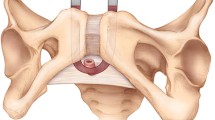Abstract
Introduction and hypothesis
To unify and organize reporting, an International Urogynecological Association (IUGA)/International Continence Society (ICS) expert consortium published terminology guidelines with a classification system for complications related to implants used in female pelvic surgery. We hypothesize that the complexity of the codification system may be a hindrance to precision, especially with decreasing levels of postgraduate expertise.
Methods
Residents, fellows, and attending physicians were asked to code seven test cases taken from published literature. Category, timing, and site components of the classification system were assessed independently and according to the level of training. Interobserver reliability was calculated as percent agreement and Fleiss’ kappa statistic.
Results
A total of 24 participants (6 attending physicians, 3 fellows, and 15 residents) were tested. The percent agreement showed significant variation when classified by level of training. In all categories, attending physicians had the greatest percentage agreement and largest kappa. The most agreement was seen when attending physicians classified mesh complications by time, 71 % agreement with kappa 0.73 [95 % confidence interval (CI) 0.58–0.88]. For the same task, the percentage agreement for fellows was 57 %, kappa 0.55 (95 % CI 0.23–0.87) and with residents 57 %, kappa 0.71([95 % CI 0.64–0.78). Interestingly, the site component of the classification system had the least overall agreement and lowest kappa [0 %, kappa 0.29 (95 % CI 0.26–0.32)] followed by the category component [14 %, kappa 0.48 (95 % CI 0.46–0.5)].
Conclusions
The IUGA/ICS mesh complication classification system has poor interobserver reliability. This trended downward with decreasing postgraduate level; however, we did not have sufficient statistical power to show an association when stratifying by all training levels. This highlights the complex nature of the classification system in its current form and its limitation for widespread clinical and research application.




Similar content being viewed by others
References
Olsen AL, Smith VJ, Bergstrom JO, Colling JC, Clark AL (1997) Epidemiology of surgically managed pelvic organ prolapse and urinary incontinence. Obstet Gynecol 89:501–506
Maher CM, Feiner B, Baessler K, Glazener CM (2011) Surgical management of pelvic organ prolapse in women: the updated summary version Cochrane review. Int Urogynecol J 22:1445–1457
FDA Safety Communication (2011) Update on serious complications associated with transvaginal placement of surgical mesh for pelvic organ prolapse. Available via http://www.fda.gov/medicaldevices/safety/alertsandnotices/ucm262435.htm. Accessed 29 Nov 2012
Diwadkar GB, Barber MD, Feiner B, Maher C, Jelovsek JE (2009) Complication and reoperation rates after apical vaginal prolapse surgical repair: a systematic review. Obstet Gynecol 113:367–373
Haylen BT, Freeman RM, Swift SE et al (2011) An International Urogynecological Association (IUGA)/International Continence Society (ICS) joint terminology and classification of the complications related directly to the insertion of prostheses (meshes, implants, tapes) & grafts in female pelvic floor surgery. Int Urogynecol J 22:3–15
Tunitsky E, Abbott S, Barber MD (2012) Interrater reliability of the International Continence Society and International Urogynecological Association (ICS/IUGA) classification system for mesh-related complications. Am J Obstet Gynecol 206:442.e1–442.e6
Rice NT, Hu Y, Slaughter JC, Ward RM (2012) Pelvic mesh complications in women before and after the 2011 FDA public health notification. Female Pelvic Med Reconstr Surg 18(Suppl 2):S138
Lo TS, Lee SJ (2007) Simple sling resection and a second, intermediate polypropylene mesh for treatment of vaginal tape protrusion concurrent with recurrent urinary stress incontinence after TVT procedure. J Obstet Gynaecol Res 33:739–742
Al-Wadi K, Al-Badr A (2009) Martius graft for the management of tension-free vaginal tape vaginal erosion. Obstet Gynecol 114:489–491
Karp D, Apostolis C, Lefevre R, Davila GW (2009) Atypical graft infection presenting as a remote draining sinus. Obstet Gynecol 114:443–445
Collins SA, Tulikangas PK, LaSala CA, Lind LR (2011) Complex sacral abscess 8 years after abdominal sacral colpopexy. Obstet Gynecol 118:451–454
Parekh MH, Minassian VA, Poplawsky D (2006) Bilateral bladder erosion of a transobturator tape mesh. Obstet Gynecol 108:713–715
Rafii A, Jacob D, Deval B (2006) Obturator abscess after transobturator tape for stress urinary incontinence. Obstet Gynecol 108:720–723
Boyles SH, McCrery R (2008) Dyspareunia and mesh erosion after vaginal mesh placement with a kit procedure. Obstet Gynecol 111:969–975
Acknowledgments
This project was supported by CTSA award No. UL1TR000445 from the National Center for Advancing Translational Sciences. Its contents are solely the responsibility of the authors and do not necessarily represent official views of the National Center for Advancing Translational Sciences or the National Institutes of Health.
Conflicts of interest
Roger R. Dmochowski is a consultant for Ferring, Johnson & Johnson, Merck, and Astellas. Melissa R. Kaufman is a consultant for Allergan, American Medical Systems, and Astellas. Meghana Gowda, Laura Chang Kit, W. Stuart Reynolds, and Li Wang have no disclaimers or conflicts of interest.
Author information
Authors and Affiliations
Corresponding author
Appendix
Appendix
Test cases extracted from published literature
Author | Year | Journal | Antecedent surgery | |
|---|---|---|---|---|
1 | Lo and Lee [8] | 2007 | J Obstet Gynaecol Res | TVT sling |
2 | Al-Wadi and Al-Badr [9] | 2009 | Obstet Gynecol | TVT sling |
3 | Karp et al. [10] | 2009 | Obstet Gynecol | Posterior IVS tunneler |
4 | Collins et al. [11] | 2011 | Obstet Gynecol | Abdominal sacral colpopexy |
5 | Parekh et al. [12] | 2006 | Obstet Gynecol | Transobturator sling |
6 | Rafii et al. [13] | 2006 | Obstet Gynecol | Transobturator sling |
7 | Boyles and McCrery [14] | 2008 | Obstet Gynecol | Vaginal mesh kit |
Rights and permissions
About this article
Cite this article
Gowda, M., Kit, L.C., Stuart Reynolds, W. et al. Interobserver variability when employing the IUGA/ICS classification system for complications related to prostheses and grafts in female pelvic floor surgery. Int Urogynecol J 24, 1671–1678 (2013). https://doi.org/10.1007/s00192-013-2078-y
Received:
Accepted:
Published:
Issue Date:
DOI: https://doi.org/10.1007/s00192-013-2078-y




